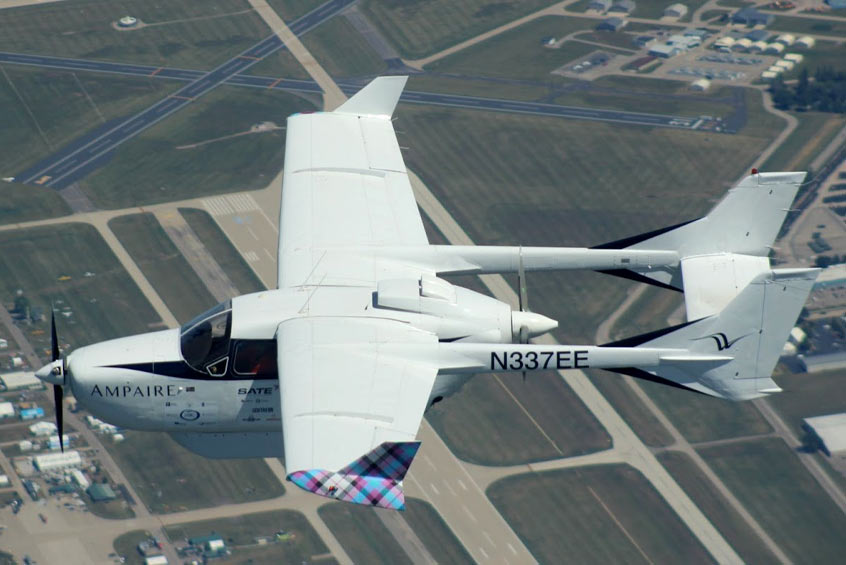ACE 2026 - The home of global charter.
 The bimonthly news publication for aviation professionals.
The bimonthly news publication for aviation professionals.

Ampaire's hybrid-electric EEL demonstrator aircraft has completed a 1,880 statute mile mission from LA to Oshkosh, Wisconsin, where it is on display at EAA AirVenture. The journey included the single longest nonstop flight ever made by a hybrid-electric aircraft; 1,135 miles.
Test pilot Elliot Seguin took off from Camarillo airport on the afternoon of 20 July to reposition to Mojave airport in California, a flight of 85 miles, in order to avoid the potential for early morning fog the next morning. The next day he flew 1,135 miles from Mojave to Hays, Kansas, and the day after that he completed the trip, flying 660 miles to Oshkosh's Wittman Regional airport.
The EEL demonstrated fuel savings of up to 40 per cent versus a standard Cessna Skymaster on which it is based. The EEL is a parallel hybrid, with one conventional combustion engine and an independent electric drivetrain. Optimised hybrid electric aircraft can demonstrate substantially higher fuel savings and emissions reductions.
“By the time the EEL returns to California it will have flown more miles than any hybrid-electric aircraft, over 15,000, including airline demonstration flights in Hawaii and the UK. It is flying with great reliability and demonstrating the workhorse nature of hybrid-electric aircraft,” says SVP of global partnerships Dr Susan Ying. “We are taking the technology and expertise developed with the electric EEL and applying it to our first commercial product, the hybrid-electric nine seat Eco Caravan regional aircraft, which will make its first flight later this year. That aircraft will demonstrate fuel savings of up to 70 per cent and emissions reductions of up to 100 per cent when using sustainable aviation fuel.”
Ampaire is moving rapidly to bring the benefits of electrification to aviation markets, starting with the Eco Caravan and scaling its technology to larger regional aircraft.
Ampaire has a key exclusive supplier for the hybrid-electric propulsion system it is developing for its Eco Caravan aircraft, an upgrade to the current Cessna Grand Caravan. Ampaire will use a RED Aircraft AO3 series compression ignition engine rated to 550 hp (405 kW) in an integrated parallel configuration. The RED engine provides the base power and the Ampaire electrical system provides the peak power.
Under the terms of an MoU between the companies, the two will work to commercialise electrified propulsion aircraft, with Ampaire developing complete hybrid-electric propulsion systems and certifying them for various applications up to 800 hp, while RED Aircraft will develop, certify and supply Jet A/SAF compatible engine subsystems to Ampaire.
The new propulsion system for the Eco Caravan offers substantial benefits to users and will be the first in a series of electrified fixed wing aircraft that reduce aviation's carbon footprint. Fuel consumption is reduced by 70 per cent on shorter trips and by 50 per cent on longer ones, with greater corresponding reductions in CO2 emissions due to the contribution of the electric motor and the optimised use of the RED engine. The RED engine provides high thermodynamic efficiency that is two times better than a comparable turboprop engine, and is JET A/SAF compatible. With SAF usage, CO2 emissions have the potential for net zero.
Engine initial costs and ongoing maintenance are substantially lower than for a turboprop engine. Durability and reliability of the RED engine has been demonstrated in applications such as the Air Tractor AT 301, an agricultural aircraft, and the YAK-52 aerobatic trainer. So the Eco Caravan operating cost is 25-40 per cent lower, depending on an operator's route structure.
Ampaire conducted the first Eco Caravan hybrid powertrain ground runs in April 2022, with plans to fly the aircraft in the second half of the year. The company is working with the FAA to achieve STC approval by 2024.
The Eco Caravan will retain the payload capabilities of the Grand Caravan, carrying up to 11 passengers or 2,500 pounds of cargo. Range improves to 1,100 nautical miles.
“The modern, powerful and ultra-fuel-efficient RED engines have exactly the right characteristics for the Eco Caravan's hybrid-electric propulsion system and for many other upgrades or all-new designs we may pursue,” says Ampaire CEO Kevin Noertker. “We are very pleased to take this first step in collaboration with a company that shares our goal to decarbonise aviation while reducing costs for aircraft operators and their passengers.”
“RED Aircraft sees enormous potential for hybrid-electric aircraft and believes the Eco Caravan is just the first step to bringing a new level of efficiency and vastly lower emissions to a large swath of aviation,” adds CEO Jürgen Schwarz. “We are thrilled to be pursuing these opportunities hand-in-hand with Ampaire.”